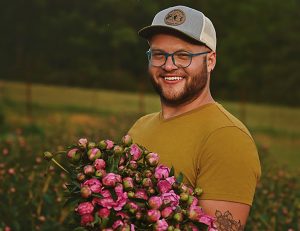Fields of dreams: From 4-H to cut flower grower
By Grant McCarty and Emily Steele University of Illinois Extension Services — March 27, 2022
Drew Groezinger is a cut flower grower in northwest Illinois. The local cut flower industry has flourished in recent years led by a supportive peer-to-peer community and a network of growers on social media. (Photo courtesy of University of Illinois Extension)
B
When Local Foods Small Farms Educator Grant McCarty is looking for inspiration, he makes his way to Clara Joyce Flowers. There, farmer Drew Groezinger inevitably has something new going on.
There are high tunnels being built, a field of newly planted hemp, propagation houses busting at the seams with trays ready to be planted, social media launches, new value-added products, and an innovative evolved farmstand. The most dramatic change has been the transition from colorful fields of vegetables to cascading seas of dahlias, ranunculus, sunflowers, peonies, and other specialty cut flowers.
To understand Clara Joyce Flowers and the work that Drew and his team do is to first understand that it was not “always flowers but it was always going to be flowers.”
From vegetables to cut flowers
A seventh-generation resident of Jo Daviess County in northwest Illinois, Drew grew up surrounded by rolling hills of farmland and family members who tilled the same soil he is now growing flowers in. His grandmother sowed those initial seeds by working with Drew on Illinois 4-H projects that let him explore horticulture projects hands-on.
At the age of 11, Drew decided to garden, which led to the development of Groezinger Produce Farm. There he sold produce at local farmers markets and a CSA. In 2015, with his first planting of dahlias, Drew started to envision what Clara Joyce Flowers could be. By 2017, he decided to go all-in by planting “6,000 dahlias and 400 peonies and blocks of annuals.”
Today, he grows on 9 acres of open field space with 20,000-square feet of greenhouses that always have something growing. The operation has full-time employees and crucial wholesale partnerships.
Flower crops and vegetable crops have different needs. Both may have similar soil needs and disease and insect pests, but appearance is everything in cut flower production. Misshapen, imperfect vegetables can be sold at farmers markets, that doesn’t hold true for cut flowers.
To shift to a customer-focused model, Drew took the time to build relationships with florists, wholesale, bridal, and farmers markets. By fostering relationships with his clients, he was also bringing his attention to detail and design experience gained while working with local florists when he was in high school. He was able to match the flowers he planned to grow with the customers he wanted to pursue.

Sharing photos of floral arrangements on the photo-focused social media platform Instagram is a way for cut flower growers to network with florists and customers. (Photo courtesy of University of Illinois Extension)
Grower to Grower support and education
The cut flower industry has a new wave of growers who depend on one another to develop and enrich their community. These growers are creating valuable networks around the United States, often hours from each other, where they are supporting and training new cut flower growers.
One of the channels cut flower growers are using to build their community is the photo-based social media platform Instagram. Drew says his Instagram account is a powerful outlet that provides a network he can rely on. With its heavy focus on photos and videos, Instagram aligns well with the aesthetic forward cut flower industry. Farmers can reach customers and partners with behind-the-scenes videos of daily farm tasks, photos of brides and wedding arrange, and direct sales ads.
At the same time, the Association of Specialty Cut Flower Growers provides opportunities for new and established growers to connect with events, research, resources, mentorships, and scholarships.
This rise in new cut flowers growers has happened quickly since Drew started Clara Joyce Flowers.
“There are 15 to 16 people that are flower farmers one to two hours away from me. And that was not what it was when I started,” Drew says. “Now if you need flowers, there are places to get beautiful, quality, and fresh products.”
Because of this community Drew has become a part of, he decided to start a podcast to share his experience and knowledge to share with others. Each week on Between Me and Drew he covers many of those questions that new and established growers ask him about cut-flower production.
More than one person
It’s then not surprising based on how Drew talks about his flowers, farm, communities, and relationships, and what he has learned in growing and building his business, that it is more than one person.
“One of the biggest misconceptions about starting your farm or business is that you have to do it on your own,” Drew says. “When you do things on your own, you can have an insane amount of pride that can come in different ways or forms. But a farm – whether specialty crops, row crops, cut flowers – a farm is fundamentally more than one person.”







